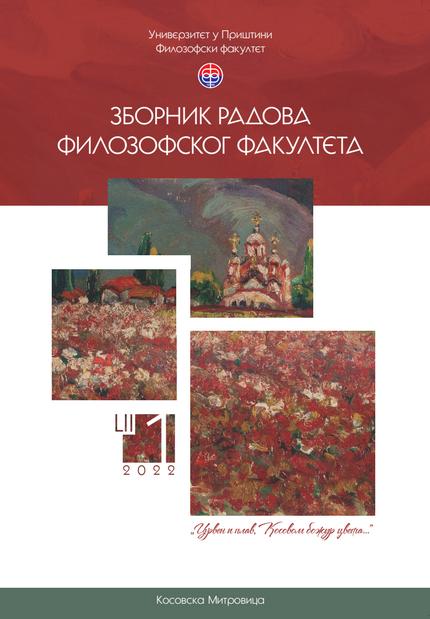Geese, Planks and Sluts: Semantic Derogation of Women in French and Serbian Slang
Abstract
The paper uses a cognitive linguistic approach to analyse slang lexemes derogatively denoting and qualifying
women in two languages neither genealogically close nor in direct contact. Starting from the conceptual metaphor theory and the linguocultural approach, our aim is to determine the similarities and differences related to the cultural knowledge about the concept of women in French and Serbian culture. Our research corpus encompasses examples excerpted from French and Serbian slang and standard dictionaries. The analysis shows that most of the slang expressions that derisively qualify women emphasise physical appearance, intellectual characteristics, and forms of behaviour that the sociolinguistic community assesses
as unacceptable and undesirable. The results confirm the deeply rooted and widespread prevalence of collective prejudice, generalisations, stereotypes, and the tendency to marginalise women.
References
Ahrens, K. & Say, A. L. T. (1999). Mapping Image-schemas and Translating Metaphors. PACLIC, 95-102. Retrieved from: http://hdl.handle.net/2065/12141
Bratić, V. & Vuković Stamatović, M. (2017). Commodification of Women Through Conceptual Metaphors: the Metaphor Woman as a Car in the Western Balkans. Gender and Language, 11 (1), 51–76. https://doi.org/10.1558/genl.22009
Bugarski, R. (2003). Žargon. Beograd: Biblioteka XX vek.
Bugarski, R. (2005). Jezik i kultura. Beograd: Biblioteka XX vek.
Dobrovol’skij, D. & Piirainen, E. (2005). Cognitive Theory of Metaphor and Idiom Analysis. Jezikoslovlje, 6 (1), 7–35. Retrieved from: https://hrcak.srce.hr/30876
Đurin, T. & Jovanović, I. (2019). An Intangible but Very Loud Heritage: Swear Words in Serbian. Revista de etnografie şi folklor, 1–2/2019 (2019), 94–115.
François, D. (1975). La littérature en argot et l’argot dans la littérature. Communication & Languages, 27, 5–27. https://doi.org/10.3406/colan.1975.4224
Guiraud, P. (1956). L'Argot. Paris: PUF.
Guiraud, P. (1978). Sémiologie de la sexualité. Paris: Payot.
Hines, C. (1999). Foxy Chicks and Playboy Bunnies: A Case Study in Metaphorical Lexicalization. In: K.H. Misako.et al. (eds.), Cultural, Typological and Psychological Perspectives on Cognitive Linguistics (9–23). Amsterdam: Benjamins.
Jovanović, J. (2014). Kognitivnolingvistička analiza frazeologizama s komponentom glava u srpskom jeziku. Naš jezik, 45/3–4, 69–88.
Jovanović, J. (2018). Leksika pogrdnog značenja u imenovanju čoveka u srpskom jeziku (unpublished doctoral dissertation). Filološki fakultet, Beograd.
Karchmar, L. (1987). Draža Mihailović and the Rise of the Četnik Movement, 1941–1945. New York: Garland Publishing.
Kiełtyka, R. & Kleparski, G. A, (2005). The Scope of English Zoosemy: The Case of Domesticated Animals. Studia Anglica Resoviensia, 3, 76–87.
Kiełtyka, R. (2005). Zoosemic Terms Denoting Female Human Beings: Semantic Derogation of Women Revisited. Studia Anglica Posnaniensia, 41, 167–186.
Kittay, E. F. (1988). Woman as Metaphor. Hypatia, 3 (2), 63–86. https://doi.org/10.1111/j.1527-2001.1988.tb00069.x
Kövecses, Z. (2003). The Scope of Metaphor. In: A. Barcelona (ed.), Metaphor and Metonymy at the Crossroads: A Cognitive Perspective (79–92). Berlin: Mouton de Gruyter. https://doi.org/10.1515/9783110894677.79
Kövecses, Z. (2010). Metaphor: A Practical Introduction (2nd ed.). Oxford: Oxford University Press.
Lakoff, G. & Johnson, M. (1980). Metaphors We Live By. Chicago: University of Chicago Press.
Lakoff, G. & Johnson, M. (1999). Philosophy in the Flesh: The Embodied Mind and Its Challenge to Western Thought. New York: Basic Books.
Lakoff, G. & Turner, M. (1989). More Than Cool Reason: A Field Guide to Poetic Metaphor. Chicago: University of Chicago Press.
Lakoff, G. (1987). Women, Fire, and Dangerous Things: What Categories Reveal About the Mind. Chicago: University of Chicago Press.
Lakoff, G. (1993). The Contemporary Theory of Metaphor. In: A. Ortony (ed.), Metaphor and Thought (202–251). Cambridge: Cambridge University Press. https://doi.org/10.1017/CBO9781139173865.013
Lakoff, G. (2006). Conceptual Metaphor: The Contemporary Theory of Metaphor. In: D. Geeraerts (ed.), Cognitive Linguistics: Basic Readings (186–238). Berlin: Mouton de Gruyter.
Lopez Rodriguez, I. (2009). Of Women, Bitches, Chickens and Vixens: Animal Metaphors for Women in English and Spanish. Culture, Language and Representation, 7, 77‒100.
Marjanović, S. (2012). Pridevske zoonimske poredbene frazeme u srpskome jeziku i njihovi korespondenti u francuskom. Zbornik za jezike i književnosti Filozofskog fakulteta u Novom Sadu, 2/2012, 95–110.
Milazzo, M. J. (1975). The Chetnik Movement & the Yugoslav Resistance. Baltimore: Johns Hopkins University Press.
Milić, G. (2013). Pristup zoosemiji u okviru teorije konceptualne metafore. Jezikoslovlje, 14 (1), 197-213. Retrieved from: https://hrcak.srce.hr/103364
Mišel, A. (1997). Feminizam. Beograd: Plato/XX vek.
Novokmet, S. (2020). Nazivi životinja u srpskom jeziku: semantička i lingvokulturološka analiza. Beograd: Institut za srpski jezik SANU.
Pamies, A. (2011). A propos de la motivation phraséologique. In: A. Pamies and D. Dobrovol’skij (eds.), Linguo-cultural Competence and Phraseological Motivation (25–39). Baltmannsweiler: Schneider Verlag Hohengehren GmbH.
Piirainen, E. (2011). Idiom Motivation from Cultural Perspectives: Metaphors, Symbols, Intertextuality. In: A. Pamies and D Dobrovol’skij (eds.), Linguo-Cultural Competence and Phraseological Motivation (65–74). Baltmannsweiler: Schneider Verlag Hohengehren GmbH.
Quinn, N. & Holland, D. (1987). Culture and Cognition. In: D. Holland & N. Quinn (eds.), Cultural Models in Language and Thought (3–40). Cambridge: Cambridge University Press. https://doi.org/10.1017/CBO9780511607660.002
Ristić, S. (2004). Ekspresivna leksika u srpskom jeziku. Beograd: Institut za srpski jezik SANU.
Ristivojević Rajković, N. (2008). Zoonimska metaforika o muškarcima i ženama. Philologia, 6, 45–52.
Ristivojević Rajković, N. (2014). Pogrdni nazivi za muškarce i žene – prilog proučavanju konceptualizacije roda. U: B. Mišić & V. Lopičić (ur.), Jezik, književnost, marginalizacija (133–142). Niš: Filozofski fakultet.
Savić, S., Čanak, M., Mitro, V. & Štasni, G. (2009). Rod i jezik. Novi Sad: Ženske studije i istraživanja, Futura Publikacije.
Silaški, N. (2013). Animal Metaphors and Semantic Derogation – Do Women Think Differently from Men? Gender studies, 12(1), 319‒332.
Stanojević, M. M. (2009). Konceptualna metafora u kognitivnoj lingvistici: pregled pojmova. Suvremena lingvistika, 35 (68), 339‒371. Retrieved from: https://hrcak.srce.hr/47111
Štrbac, G. & Štasni, G. (2017). Somatizmi i konceptualizacija stvarnosti u srpskom jeziku (glava i njeni delovi). Novi Sad: Filozofski fakultet.
Telija, V. N. (1996). Russkaja frazeologija: semantičeskij, pragmatičeskij i lingvokul'turologičeskij aspekty. Moskva: Jazyki Russkoj Kul’tury.
Trask, R. L. (1999). Key Concepts in Language and Linguistics. London and New York: Routledge.
Vulović, N. (2015). Srpska frazeologija i religija. Lingvokulturološka istraživanja. Beograd: Institut za srpski jezik SANU.
Wolf, E. (1985). Funkcional'naja semantika ocenki. Moskva: Nauka.
The details about the publication policy, including copyright and licensing, are available at:

